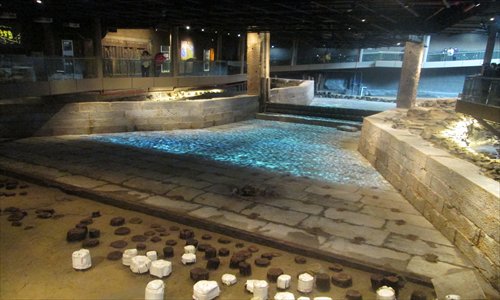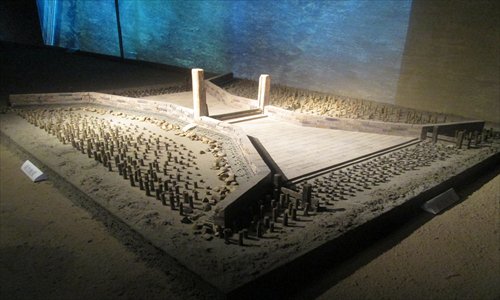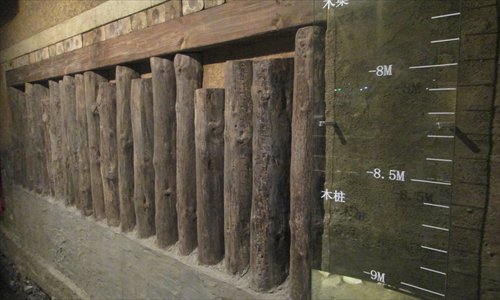A Yuan Dynasty (1279-1368) water gate site excavated in Putuo district was hailed as one of China's top 10 archaeological discoveries of 2006. And on December 31, 2012, the Shanghai Yuan Dynasty Water Gate Museum, which is built on top of the site of these relics, was officially opened to the public.
The water gate is recognized as among the biggest and best preserved Yuan Dynasty sites of its kind ever discovered in the country.
Back in 2001, the site was accidentally chanced upon when a steel drill penetrated through a layer of limestone slabs and a level of wooden joists, all of which were seven to 12 meters below the surface of the ground.

The inside of the museum
Unexpected discovery
"It was the discovery of hourglass-shaped iron tenons used to fix the limestone slabs that made experts aware of what had been found," said Zhang Lan, the executive director of the Shanghai History Museum, which is in charge of operating the museum. "These iron tenons are shaped like the yuanbao (gold ingots) that were officially named during the Yuan Dynasty. So archeologists quickly realized that whatever they had found was possibly connected with that era."
From 2001 to 2006, the 1,500-square meter site was gradually uncovered in front of excited archeologists. And according to an analysis of the soil layers, as well as examining excavated upright wooden posts which had Phags-pa letters (an alphabet created for the Yuan emperor Kublai Khan (1215-1294), as a unified script for the literary languages of the era) engraved on them, the date of the construction was conclusively declared to have been during the Yuan Dynasty.
Referring to a book called A Collection of Essays on Water Conservation written by the Shanghai-born Yuan Dynasty official Ren Renfa, who built 10 water gates from 1304 to 1324, the site was finally recognized as Zhidan Yuan, one of the six water gates built by Ren in 1324.
The museum roof is shaped to resemble water flowing through such a water gate, and the museum also showcases the wider scenic landscape of the site, including the water gate, the stone ground on either side of the gate, the two limestone walls that extend tens of meters sideways from the water gate and two meters high, and hundreds of wooden posts outside the limestone walls.
"It was the discovery of hourglass-shaped iron tenons used to fix the limestone slabs that made experts aware of what had been found," said Zhang Lan, the executive director of the Shanghai History Museum, which is in charge of operating the museum. "These iron tenons are shaped like the yuanbao (gold ingots) that were officially named during the Yuan Dynasty. So archeologists quickly realized that whatever they had found was possibly connected with that era."
From 2001 to 2006, the 1,500-square meter site was gradually uncovered in front of excited archeologists. And according to an analysis of the soil layers, as well as examining excavated upright wooden posts which had Phags-pa letters (an alphabet created for the Yuan emperor Kublai Khan (1215-1294), as a unified script for the literary languages of the era) engraved on them, the date of the construction was conclusively declared to have been during the Yuan Dynasty.
Referring to a book called A Collection of Essays on Water Conservation written by the Shanghai-born Yuan Dynasty official Ren Renfa, who built 10 water gates from 1304 to 1324, the site was finally recognized as Zhidan Yuan, one of the six water gates built by Ren in 1324.
The museum roof is shaped to resemble water flowing through such a water gate, and the museum also showcases the wider scenic landscape of the site, including the water gate, the stone ground on either side of the gate, the two limestone walls that extend tens of meters sideways from the water gate and two meters high, and hundreds of wooden posts outside the limestone walls.

A model of the water gate
The tide was high
Walking along the glass floor that encircles the outer boundary of the water gate, visitors can examine the construction of this ancient site from a variety of angles.
The water gate was built to dam and wash away the silt that had built up in the water due to the rising tides of the sea. When the tide came in, the gate was closed to stop the water and silt outside, and when the tide went out, the gate was opened to release fresh water from the river to wash away the remaining silt.
A cutaway diagram reproduction of the groundwork of the water gate depicts clearly the solid structure of the site. From the bottom to the top layer are, respectively, upright wooden posts, long wooden joists, compactly-laid wooden flooring, and flat and smooth limestone slabs.
There are some 10,000 wooden posts as part of the site, with only one fifth of the total being uncovered. The rest have been left under the earth to better safeguard their protection. Most of the wooden posts contain carvings with phags-pa letters.
"Chinese people have an old saying, wu le gong ming, which means that products should be inscribed with the names of their producers to guarantee their quality. And the inscriptions on those wooden posts shows that they were considered of the best quality at that time," Zhang told the Global Times.
The construction of the water gate site was strictly carried out in accordance with the State Building Standards, an official book compiled in the Northern Song Dynasty (960-1127). Along the glass walkway visitors can see projections of a series of 12 images taken from the book, detailing the individual steps in the construction process.
Walking along the glass floor that encircles the outer boundary of the water gate, visitors can examine the construction of this ancient site from a variety of angles.
The water gate was built to dam and wash away the silt that had built up in the water due to the rising tides of the sea. When the tide came in, the gate was closed to stop the water and silt outside, and when the tide went out, the gate was opened to release fresh water from the river to wash away the remaining silt.
A cutaway diagram reproduction of the groundwork of the water gate depicts clearly the solid structure of the site. From the bottom to the top layer are, respectively, upright wooden posts, long wooden joists, compactly-laid wooden flooring, and flat and smooth limestone slabs.
There are some 10,000 wooden posts as part of the site, with only one fifth of the total being uncovered. The rest have been left under the earth to better safeguard their protection. Most of the wooden posts contain carvings with phags-pa letters.
"Chinese people have an old saying, wu le gong ming, which means that products should be inscribed with the names of their producers to guarantee their quality. And the inscriptions on those wooden posts shows that they were considered of the best quality at that time," Zhang told the Global Times.
The construction of the water gate site was strictly carried out in accordance with the State Building Standards, an official book compiled in the Northern Song Dynasty (960-1127). Along the glass walkway visitors can see projections of a series of 12 images taken from the book, detailing the individual steps in the construction process.

A cutaway diagram reproduction of the groundwork of the water gate
Urgent priority
Since the Song Dynasty (960-1279), the Wusong River, which is called Suzhou Creek once it enters Shanghai, has long been an important channel for Taihu Lake in Jiangsu Province to exit into the sea.
According to ancient documents, the width of the Wusong River decreased from 10 kilometers to only 500 meters between the Tang and Yuan dynasties, which made it an urgent priority for officials to build water conservation projects in order to stop the river from drying out.
And Zhidan Yuan became one such project on the river, even though the site of the water gate is now more than one kilometer away from Suzhou Creek. How the course of the river has actually changed throughout history is still unknown, according to Zhang. The other mystery raised by the water gate site is where exactly the other nine Shanghai projects by Ren are located.
Also on view in the museum are excavated items such as wooden tamping hammers, fish bone fossils, and ancient coins, as well as celadon washers (to wash painting and calligraphy brushes) and bowls from the Longquan ware kiln, most of which were produced in Longquan city in Zhejiang Province.
Since the Song Dynasty (960-1279), the Wusong River, which is called Suzhou Creek once it enters Shanghai, has long been an important channel for Taihu Lake in Jiangsu Province to exit into the sea.
According to ancient documents, the width of the Wusong River decreased from 10 kilometers to only 500 meters between the Tang and Yuan dynasties, which made it an urgent priority for officials to build water conservation projects in order to stop the river from drying out.
And Zhidan Yuan became one such project on the river, even though the site of the water gate is now more than one kilometer away from Suzhou Creek. How the course of the river has actually changed throughout history is still unknown, according to Zhang. The other mystery raised by the water gate site is where exactly the other nine Shanghai projects by Ren are located.
Also on view in the museum are excavated items such as wooden tamping hammers, fish bone fossils, and ancient coins, as well as celadon washers (to wash painting and calligraphy brushes) and bowls from the Longquan ware kiln, most of which were produced in Longquan city in Zhejiang Province.
Date: All year, 9 am to 4 pm (closed on Mondays)
Venue: Shanghai Yuan Dynasty Water Gate Museum
元代水闸遗址博物馆
Address: 619 Yanchang Road West
延长西路619号
Admission: Free, but visitors need to show their ID cards or passports to get an admission ticket, and group visitors of more than 10 people should make a reservation two days in advance.
Call 1521-4380-020 for details
Venue: Shanghai Yuan Dynasty Water Gate Museum
元代水闸遗址博物馆
Address: 619 Yanchang Road West
延长西路619号
Admission: Free, but visitors need to show their ID cards or passports to get an admission ticket, and group visitors of more than 10 people should make a reservation two days in advance.
Call 1521-4380-020 for details
1 comment:
A highly recommendable museum, if interested in old Shanghai, water management and the connection with the Grand Canal...
Post a Comment